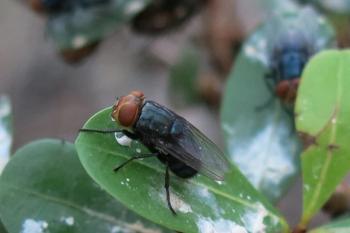
Septic arthritis in foals
During foaling season, equine practitioners are asked to examine foals that present with lameness or joint effusion. Many times the owners will report that the foal was noticed to be a little "off" for the past few days, and they assumed the mare stepped on it. These words should alert the practitioner to the real possibility of the foal having a septic arthritis or osteomyelitis. Because of the seriousness of the potential problem, all lame neonatal foals should be considered to have a septic joint, epiphysis or physis until proven otherwise.
During foaling season, equine practitioners are asked to examine foals that present with lameness or joint effusion. Many times the owners will report that the foal was noticed to be a little "off" for the past few days, and they assumed the mare stepped on it. These words should alert the practitioner to the real possibility of the foal having a septic arthritis or osteomyelitis. Because of the seriousness of the potential problem, all lame neonatal foals should be considered to have a septic joint, epiphysis or physis until proven otherwise.
Septic arthritis in the foal often is accompanied by a history of some incident that may have resulted in a decrease in the ingestion of adequate maternal antibodies from colostrum. The mare might have leaked colostrums before parturition. The foal might have been delayed in suckling. One study by McCoy found that the foals with failure of passive transfer were 1.7 to 1.9 times more likely to develop septic arthritis or septic osteomyelitis, respectively, than foals that received adequate colostrum.
Suggested Reading
Foals presenting with septic arthritis are usually less than 1 month of age. Clinically, the younger (birth to 36 hours) neonatal foal presents with joint effusion as a part of general signs of septicemia in the first day of life. Alternatively, the slightly older neonate (>36 hours) may appear relatively normal at first and develop lameness over a period of days or even weeks. Owners might report that the foal seems to spend more time recumbent than other foals. Evidence of thickened or leather-like skin over boney prominences, such as the elbows, hips, hocks and carpi, are the signs of the development of pressure decubital ulcers secondary to orthopedic pain and recumbency (Photo 1).
Careful palpation of all joints and physis should be done on the physical examination of the neonatal foal. Though all joints and growth plates in the foal have the potential for hematogenous infection, the joints of the axial skeleton are affected most often. The site prevalence varies with different studies, but the tarsus, stifle, fetlock and carpus are affected frequently. Subtle joint effusion can be detected by palpating the opposite joint for comparison. Septic physitis may not present with joint swelling but rather with edema over the growth-plate region. Pressure at this site can illicit a painful response from the foal.
Arthrocentesis of a distended joint is usually straightforward. The joint to be aspirated is surgically prepared and an 18-gauge or 20-gauge needle is directed into the distended joint capsule. Landmarks for the different joints are published. The clinician should aspirate enough fluid to place it in an EDTA tube for fluid analysis, blood culture media for incubation and on a culturette for immediate plating.
Normal synovial fluid analysis yields a cell count of less than 250 cells/mm3. Though the differential count should have a mixture of neutrophils, lymphocytes and mononuclear cells, neutrophils should make up less than 10 percent of the distribution. Protein levels in the fluid can be measured on a refractometer and should be less than 2 gm/dl. Normal synovial fluid has a high level of viscosity. This can be determined practically by watching a fluid drop from the syringe or placing a drop of fluid between two fingers. Normal synovial fluid should have a stringiness to it.
Synovial fluid from infected joints has a high WBC count and an elevated protein. Cell counts can range from several thousand to several-hundred thousand. The differential of cells in the infected joint is generally >90 percent neutrophils. Bacteria occasionally can be seen on a Gram stain of the fluid. The joint fluid from infected joints becomes serous in nature, losing its stringiness.
Imaging
Radiographic examination of effected joints is helpful in determining the primary site of the joint that is infected, but often bone involvement is not seen in the early stages of the disease process. Computerized tomography (CT) has been shown to demonstrate osteomyelitis in foals before radiographic changes; therefore, it might be helpful in identifying boney involvement at an earlier stage of the disease process (Photo 1). If CT is not available, and the foal does not respond to therapy, then radiographs should be repeated every three to five days. Epiphyseal or physeal lesions may become more evident over time.
Treatment of a septic joint is directed at providing immunologic support, anti-microbial coverage and specific joint health maintenance. Immunologic support is accomplished with the use of intravenous plasma to increase immunoglobulin levels. Antimicrobial coverage is directed at the selection and administration of the most effective antibiotic both systemically and locally. Specific joint health maintenance is aimed at removing the proteolytic enzymes that are present in the diseased joint and restoring the viscosity of the joint fluid.
Systemic antibiotics are not effective in eliminating the deep-seated synovitis or osteomyelitis in most cases. Intra-articular antimicrobial injection achieves very high local concentration of the drug, much greater than that which can be achieved by systemic antibiotics alone. Lloyd et al. found that synovial gentamicin concentration in E. coli experimentally infected joints was 1,000 times greater in joints that had received intra-articular gentamicin than in joints of those animals that had received only systemic gentamicin. In addition, the levels remained above MIC of most pathogenic organisms for at least 24 hours.
Regional limb perfusion (RLP) of antibiotics is also a useful technique in achieving high local concentration of antibiotic to the infected synovial lining or bone. RLP is best performed in the anesthetized foal.
Joint lavage has been a technique to relieve the tension on a joint and diluting the inflammatory products. Joint lavage is also best performed in the heavily sedated or anesthetized foal. A through and through lavage with sterile saline may be adequate in joints that don't have much fibrin and don't have bone involvement (Photo 2). For difficult joints, such as the shoulder and hip, a single needle can be used to distend and aspirate the joint.
In joints where there is a large amount of fibrin as evidenced by ultrasound or poor flushing or there are epiphyseal lesions that connect to the joint, arthroscopic evaluation, and large volume flushing is helpful. Subchondral lesions can be curetted and fibrin removed. In chronic nonresponsive joints, arthrotomy with open or closed drainage may be indicated.
Other adjunctive therapies that may be helpful for the foal with septic arthritis include the use of chondroprotective agents. The oral administration of chondroitin sulfate and glucosamine can be administered easily to effected foals. The use of hyaluronate sodium also has been advocated in effected foals.
Septic arthritis/osteomyelitis is an emergency situation. Delayed treatment can result is permanent orthopedic damage. Septic arthritis or "joint ill" was a death sentence to foals in the past. Short-term survival of effected foals has improved greatly during the last 20 years. The keys to success with effected foals are early recognition and aggressive therapy.
It is also important to look at the future productivity of effected foals when discussing prognosis with owners. Therapy is expensive. In general, foals with septic arthritis/osteomyelitis have long hospitalization times, multiple anesthesias for joint lavage and RLP, long-term antibiotics and possible arthroscopic surgery. Sometimes, financial constraints from the owner limit the aggressiveness of the treatment, and they can lead to euthanasia.
Studies looking at the racing performance of horses that had septic arthritis as foals suggest that this disease does decrease, but doesn't eliminate, the chance of the horse making it to the races. No studies have looked at the athletic careers of formerly effected foals that were not destined to be racehorses. It is possible that formerly effected animals can have a good prognosis for less-demanding activities.
Dr. Mary Rose Paradis has been on the faculty of Tufts University School of Veterinary Medicine since 1983. Currently, she is an associate professor in the Department of Clinical Sciences and the director of the Marilyn Simpson Equine Neonatal Intensive Care Unit at Tufts. She earned her DVM from University of Georgia in 1978 and her MS from Washington State University in 1980. She completed residency training at Washington State University (1978-1980) and Michigan State University (1980-1981). She was in an equine private practice on Long Island, N.Y. for 2 years before coming to Tufts.
Dr. Paradis is a diplomate of the American College of Veterinary Internal Medicine (ACVIM) in the Specialty of Large Animal Internal Medicine and currently is ACVIM's president. Her clinical and research interests lie in the diseases of the equine neonate and geriatric individual, two ends of the age spectrum. She currently is editing a new, case-based equine neonatal medicine book.
Newsletter
From exam room tips to practice management insights, get trusted veterinary news delivered straight to your inbox—subscribe to dvm360.




